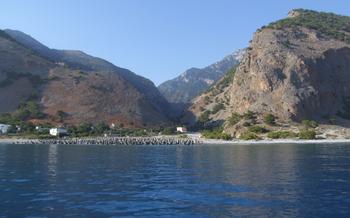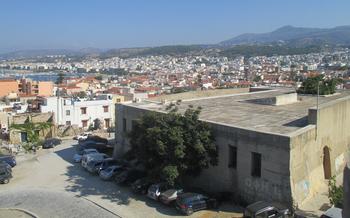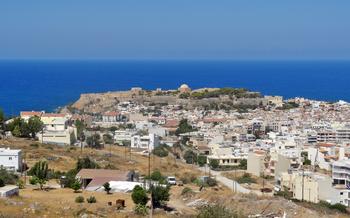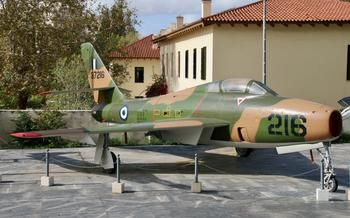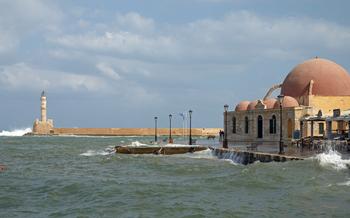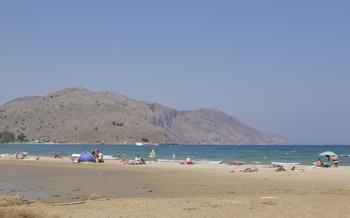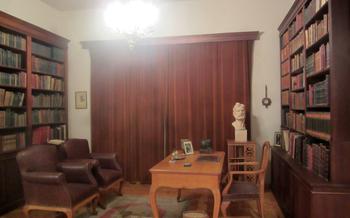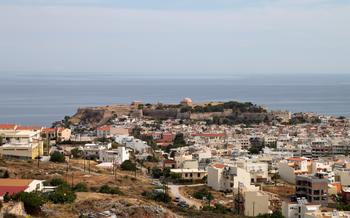
The War Shelter of Platanias
- The War Shelter of Platanias: A Hidden Gem of History
- Unveiling the History of Platanias
- Stepping Inside the War Shelter
- The Shelter's Role in World War II
- Platanias' Contribution to the Resistance
- The Liberation of Platanias
- Platanias Today: A Thriving Tourist Destination
- Exploring the Surrounding Area
- Capturing the Essence of Platanias
- Honoring the Past, Embracing the Present
- Insider's Tips for Exploring Platanias
- Recommended Restaurants in Platanias
- Insider Tip: Supporting Local Businesses
The War Shelter of Platanias: A Hidden Gem of History
During World War II, the War Shelter of Platanias played a crucial role in protecting civilians and soldiers from enemy attacks. Built in the 1940s, this underground shelter served as a refuge for thousands of people seeking shelter from the relentless air raids that plagued the region. Its unique design, featuring multiple chambers and reinforced concrete walls, ensured the safety of those who sought refuge within its confines.
Today, the War Shelter of Platanias stands as a testament to the resilience and courage of the Greek people during one of the darkest periods in their history. It has been carefully restored and preserved as a historical site, allowing visitors to step back in time and experience the palpable sense of history that permeates its walls. Guided tours are available, providing visitors with insights into the shelter's construction, its role in the war, and the personal stories of those who sought refuge within its walls.
Unveiling the History of Platanias
Platanias, a picturesque town in western Crete, boasts a rich and diverse history that dates back to ancient times. Its strategic location, at the crossroads of important trade routes, made it a hub for commerce and a melting pot of cultures.
In ancient times, Platanias was part of the powerful city-state of Aptera, whose ruins can still be seen today. The town flourished during the Roman and Byzantine periods, as evidenced by the remains of early Christian basilicas.
Platanias came under Venetian rule in the 13th century, and its Venetian heritage is still visible in the town's architecture and street layout. The Venetians built a fortress to protect the town from pirate attacks, and many of the town's buildings date from this period.
In the 17th century, Platanias was conquered by the Ottoman Turks, who ruled the town for over two centuries. During the Ottoman period, Platanias became a center of olive oil production, and many of the town's olive groves date from this time. The Ottoman legacy can still be seen in the town's mosques and minarets.
In the 19th century, Platanias played a significant role in the Greek War of Independence, and the town was liberated from Ottoman rule in 182Platanias became part of the modern Greek state, and it has since developed into a thriving tourist destination.
Stepping Inside the War Shelter
Journey into the heart of the War Shelter of Platanias and immerse yourself in a tangible piece of history. Its layout, strategically designed for protection, reveals various sections that served specific purposes during the war. Discover the shelter's control room, where crucial decisions were made, and the sleeping quarters, where civilians and soldiers sought refuge from the horrors of war.
Artifacts and exhibits, carefully preserved and displayed, narrate the shelter's compelling story. Gaze upon uniforms, helmets, and personal belongings that once belonged to those who sought safety within these walls. Multimedia presentations bring the shelter's past to life, showcasing historical footage, interviews with survivors, and interactive displays that allow visitors to connect with the experiences of those who lived through this tumultuous period.
Guided tours, led by knowledgeable and passionate guides, offer a deeper dive into the shelter's history and significance. They share captivating stories of resilience, courage, and the unyielding spirit of the human soul in the face of adversity. Through their insights, you'll gain a profound understanding of the shelter's role in World War II and its enduring legacy as a symbol of hope and resistance.
The Shelter's Role in World War II
The War Shelter of Platanias played a pivotal role during World War II as a refuge for civilians seeking shelter from air raids and a strategic base for resistance activities. Constructed in the late 1930s in anticipation of the war, the shelter provided a safe haven for thousands of civilians, including women, children, and the elderly, who fled to its underground chambers to escape the relentless bombing campaigns of the Axis forces.
Beyond its function as a civilian shelter, the War Shelter of Platanias also served as a significant hub for resistance activities against the Axis occupation. Local resistance groups, including the National Liberation Front (EAM) and the National Liberation Army (ELAS), used the shelter as a meeting point, a storage facility for weapons and supplies, and a base for planning and coordinating their operations.
The shelter's strategic location, hidden underground and surrounded by olive groves, made it an ideal location for resistance activities. From the shelter, resistance fighters launched sabotage operations, gathered intelligence, and provided support to Allied forces. The shelter's role in the resistance movement was instrumental in undermining the Axis occupation and contributing to the eventual liberation of Platanias and the surrounding region.
Platanias' Contribution to the Resistance
During the Axis occupation of Greece in World War II, Platanias played a significant role in the resistance movement. Local resistance groups, such as the National Liberation Front (EAM) and the National Republican Greek League (EDES), were formed to fight against the occupying forces. These groups carried out acts of sabotage, such as disrupting communication lines and attacking German and Italian troops. They also provided intelligence to the Allies and helped to organize escape routes for Allied soldiers and Greek civilians.
Hidden routes and safe houses were established throughout the region to facilitate the movement of resistance fighters and to provide shelter for those who were being pursued by the Axis forces. Local residents often risked their own lives to help the resistance fighters, providing them with food, shelter, and information. The town of Platanias became a hub for resistance activities, and its people played a vital role in the fight for freedom and independence.
The Liberation of Platanias
In 1944, the tide of World War II turned in favor of the Allied forces, and the liberation of Greece from Axis occupation became imminent. Platanias, like many other towns and villages in Crete, played a significant role in the liberation efforts.
Allied forces, composed of British and Greek troops, landed on the island in May 1944, and fierce fighting ensued. Platanias, being a strategic location, became a focal point of the battle. The town's residents actively participated in the liberation struggle, providing support and assistance to the Allied forces.
The liberation of Platanias was a hard-fought victory, and many lives were lost. The town was finally liberated on June 23, 1944, after intense fighting and heavy casualties. The liberation brought immense joy and relief to the local population, who had endured years of occupation and hardship.
Today, Platanias commemorates its liberation with pride and gratitude. Every year, on June 23, the town holds celebrations and events to honor the memory of those who fought for freedom and to celebrate the triumph of the Allied forces. Liberation Day is a time for reflection, remembrance, and celebration in Platanias, as the town pays tribute to its heroic past and the sacrifices made by its people.
Platanias Today: A Thriving Tourist Destination
Platanias has transformed into a vibrant tourist destination, attracting visitors from around the world with its picturesque charm, culinary delights, and lively atmosphere. The town's stunning beaches, such as Platanias Beach and Agia Marina Beach, offer crystal-clear waters, golden sands, and a range of water sports activities. Visitors can stroll along the scenic promenade, admiring the beautiful views of the Mediterranean Sea and the White Mountains.
Platanias is also a culinary paradise, offering a tantalizing array of traditional Cretan dishes and international cuisine. From fresh seafood to succulent grilled meats and mouthwatering pastries, there's something to satisfy every palate. Visitors can indulge in delicious meals at traditional tavernas, waterfront restaurants, or cozy cafes, each offering a unique culinary experience.
As the sun sets, Platanias transforms into a vibrant nightlife hub, with a variety of bars and clubs catering to every taste. From live music venues to beachside cocktail bars, there's something for everyone to enjoy. Visitors can dance the night away, sip on refreshing cocktails, and soak up the electric atmosphere of this charming town.
Platanias is also an ideal base for exploring the surrounding region. Day trips to nearby towns and villages, such as Chania, Rethymno, and Heraklion, offer a glimpse into Crete's rich history and culture. Visitors can explore ancient ruins, wander through charming streets, and sample local delicacies in these picturesque destinations.
Exploring the Surrounding Area
Beyond the War Shelter of Platanias, the region offers a wealth of attractions that beckon the curious traveler. Pristine beaches, such as Platanias Beach and Agia Marina Beach, invite sun-seekers to soak up the Mediterranean sun and indulge in refreshing swims in the turquoise waters. History buffs can delve deeper into the region's rich past by visiting other historical landmarks, including the Ancient City of Aptera, with its impressive ruins and ancient theater, and the Venetian Fortress of Rethymno, a testament to the region's Venetian heritage.
Nature enthusiasts will be captivated by the stunning landscapes and natural wonders that surround Platanias. The Samaria Gorge, one of the longest gorges in Europe, offers breathtaking hiking trails amidst towering cliffs and lush vegetation. The White Mountains, with their snow-capped peaks and rugged terrain, provide ample opportunities for trekking, mountain climbing, and exploring traditional mountain villages. Day trips to nearby towns and villages, such as Chania, Rethymno, and Heraklion, offer a chance to discover more of Crete's diverse cultural and historical offerings.
Capturing the Essence of Platanias
Platanias offers a wealth of opportunities to capture the essence of this captivating town through photography. With its picturesque beaches, charming streets, and stunning natural surroundings, there's no shortage of Instagrammable moments waiting to be discovered. Don't miss the chance to capture the beauty of the War Shelter of Platanias, a poignant reminder of the town's resilience during World War II.
Photography Tips:
-
Golden Hour Magic: Plan your visit to the shelter during the golden hours of sunrise or sunset to capture the most flattering light for your photographs. The warm glow of the sun will enhance the shelter's historic charm and create a truly captivating atmosphere.
-
Composition: Experiment with different angles and perspectives to create visually interesting compositions. Capture the shelter's imposing facade, explore the intricate details of its architecture, or frame it against the backdrop of the surrounding landscape for a sense of scale.
-
Storytelling Through Details: Pay attention to the small details that tell the story of the shelter. Capture the weathered stone walls, the worn steps, or the remnants of wartime graffiti to convey a sense of history and authenticity.
-
People and Emotion: Incorporate people into your shots to add a human element and convey the emotional weight of the shelter's past. Capture visitors exploring the exhibits, locals sharing their stories, or moments of reflection and remembrance.
-
Drone Photography: If you have a drone, take advantage of the aerial perspective to capture stunning panoramic shots of the shelter and its surroundings. This unique vantage point will allow you to showcase the shelter's strategic location and its relationship to the town and the sea.
Share your Platanias experiences with the world by tagging your photos with relevant hashtags and engaging with the local community on social media. Let your images inspire others to discover the hidden gems and rich history of this remarkable town.
Honoring the Past, Embracing the Present
The War Shelter of Platanias serves as a poignant reminder of the sacrifices made during World War II and the indomitable spirit of the Greek people. Visiting the shelter is not only a journey through history but also an opportunity to honor the memory of those who fought for freedom. The preservation of the shelter and other historical sites in Platanias is a testament to the importance of remembering the past and learning from it.
Sustainable tourism practices play a crucial role in protecting the environment and preserving the local culture of Platanias. By choosing to travel responsibly, visitors can minimize their impact on the environment and support local businesses that operate in a sustainable manner. Embracing cultural exchange is another essential aspect of travel, as it allows visitors to learn about and appreciate different cultures while sharing their own experiences and perspectives.
Insider's Tips for Exploring Platanias
Beyond the well-known attractions, Platanias offers a treasure trove of hidden gems waiting to be discovered. Venture off the beaten path to uncover charming backstreets, secluded beaches, and unique cultural experiences. Explore the local markets, where you can find fresh produce, traditional handicrafts, and one-of-a-kind souvenirs. Immerse yourself in the vibrant culinary scene by trying local specialties such as dakos salad, gamopilafo, and loukoumades. Visit traditional tavernas to savor authentic Cretan cuisine in a warm and welcoming atmosphere. Don't miss the opportunity to attend local festivals and events, where you can witness traditional music, dance, and celebrations that showcase the rich culture of Platanias.
Recommended Restaurants in Platanias
Platanias offers a diverse culinary scene, from traditional tavernas serving authentic Cretan dishes to waterfront restaurants with breathtaking sea views. For a taste of traditional Cretan cuisine, try "To Steki tou Ilia" or "To Kafeneion," known for their warm and welcoming atmosphere and delicious dishes prepared with fresh local ingredients. If you prefer waterfront dining, head to "The Sea House" or "Ammos Beach Bar" to savor fresh seafood dishes while enjoying stunning views of the Mediterranean Sea. For those seeking international cuisine, "La Trattoria" offers authentic Italian dishes, while "Le Bistrot" serves classic French cuisine. Vegetarians and vegans will find a variety of options at "The Green Bowl," which offers a delicious and innovative plant-based menu.
Insider Tip: Supporting Local Businesses
As a responsible traveler, it's essential to support local businesses and contribute to the economic well-being of the Platanias community. By doing so, you're not only ensuring the preservation of the town's unique character but also fostering sustainable tourism practices. Make an effort to shop at family-run stores, dine at traditional tavernas, and book tours with local operators. Choose restaurants that emphasize local ingredients and support local farmers and fishermen. Buying locally made souvenirs and products is a great way to take a piece of Platanias back home while supporting the local economy. Participating in local activities and events is another fantastic way to connect with the community and gain insights into its culture and traditions. By embracing these practices, you can help preserve the authenticity of Platanias and ensure that its vibrant spirit continues to thrive for generations to come.
